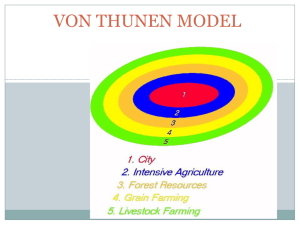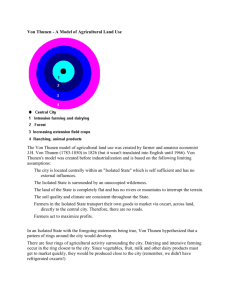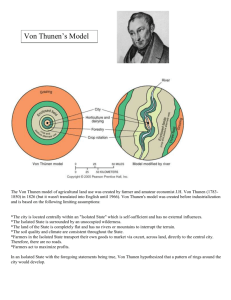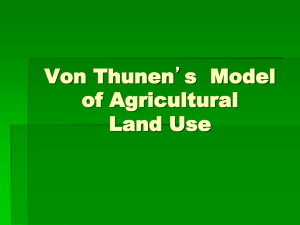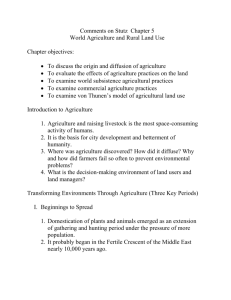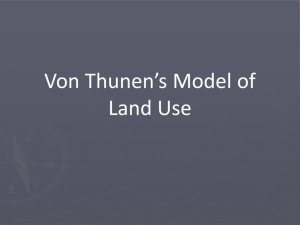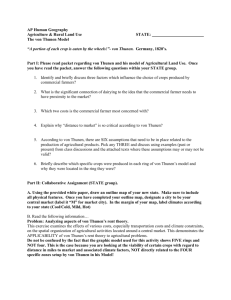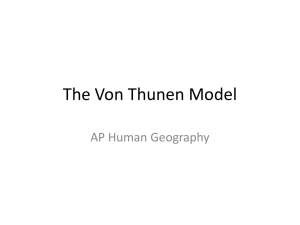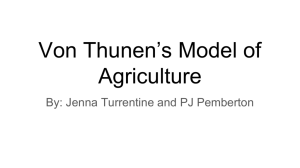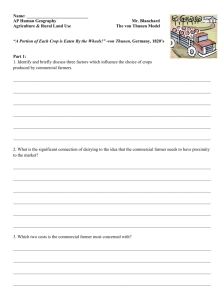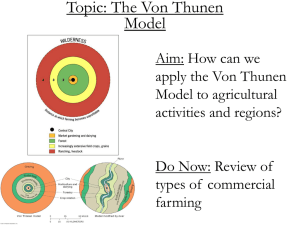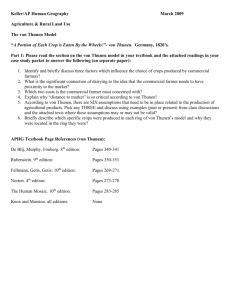Von Thunen - A Model of Agricultural Land Use The Von Thunen
advertisement
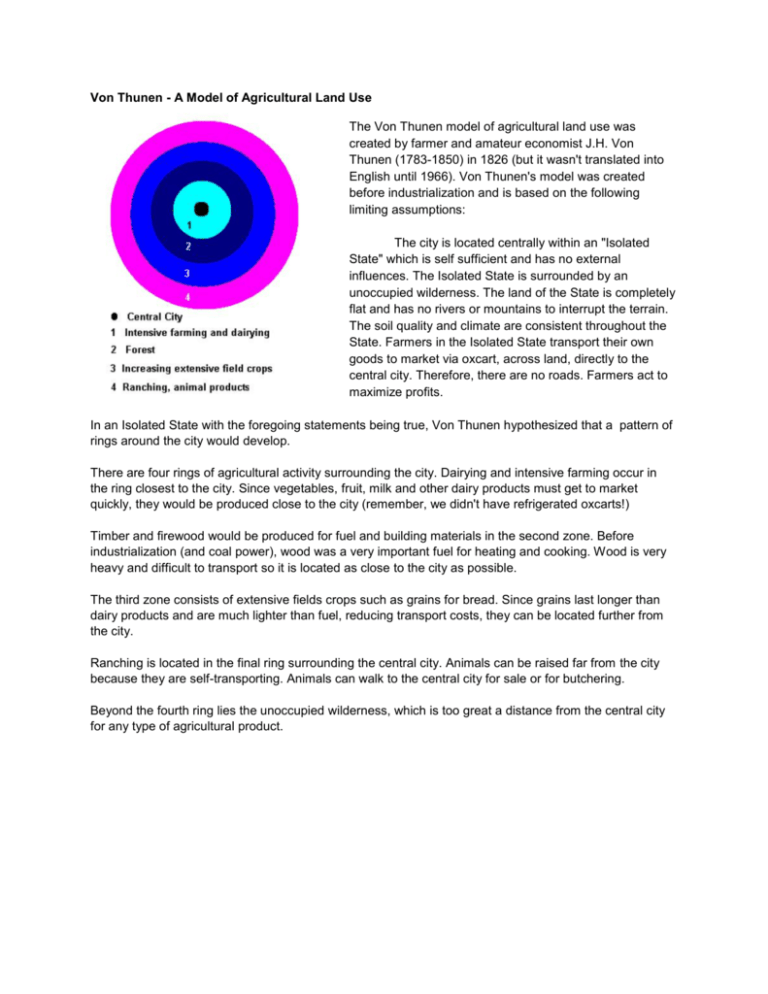
Von Thunen - A Model of Agricultural Land Use The Von Thunen model of agricultural land use was created by farmer and amateur economist J.H. Von Thunen (1783-1850) in 1826 (but it wasn't translated into English until 1966). Von Thunen's model was created before industrialization and is based on the following limiting assumptions: The city is located centrally within an "Isolated State" which is self sufficient and has no external influences. The Isolated State is surrounded by an unoccupied wilderness. The land of the State is completely flat and has no rivers or mountains to interrupt the terrain. The soil quality and climate are consistent throughout the State. Farmers in the Isolated State transport their own goods to market via oxcart, across land, directly to the central city. Therefore, there are no roads. Farmers act to maximize profits. In an Isolated State with the foregoing statements being true, Von Thunen hypothesized that a pattern of rings around the city would develop. There are four rings of agricultural activity surrounding the city. Dairying and intensive farming occur in the ring closest to the city. Since vegetables, fruit, milk and other dairy products must get to market quickly, they would be produced close to the city (remember, we didn't have refrigerated oxcarts!) Timber and firewood would be produced for fuel and building materials in the second zone. Before industrialization (and coal power), wood was a very important fuel for heating and cooking. Wood is very heavy and difficult to transport so it is located as close to the city as possible. The third zone consists of extensive fields crops such as grains for bread. Since grains last longer than dairy products and are much lighter than fuel, reducing transport costs, they can be located further from the city. Ranching is located in the final ring surrounding the central city. Animals can be raised far from the city because they are self-transporting. Animals can walk to the central city for sale or for butchering. Beyond the fourth ring lies the unoccupied wilderness, which is too great a distance from the central city for any type of agricultural product. Even though the Von Thunen model was created in a time before factories, highways, and even railroads, it is still an important model in geography. The Von Thunen model is an excellent illustration of the balance between land cost and transportation costs. As one gets closer to a city, the price of land increases. The farmers of the Isolated State balance the cost of transportation, land, and profit and produce the most cost-effective product for market. Of course, in the real world, things don't happen as they would in a model. Agricultural Location Theory in Human Geography There are a lot of factors that influence how and where agriculture (farming) can be practiced. Some of those factors are physical: soils, climate, and vegetation. Some of those factors are human: food preferences, dietary habits (how many pigs are grown in the Middle East, where pork is a taboo to both Jews and Muslims?), political considerations (tariffs, subsidies), and other factors. One way to look at agricultural location decisions and practices is to look at the profit motive, and this is especially true in the capitalist economic system. Of course, the other locational factors have to be satisfied first (profit is not a consideration if it is too wet to grow wheat or too dry to grow rice). This necessarily involves commercial agriculture rather than any kind of subsistence system. Von Thunen and Economic/Locational rent. Note that the term “rent” has many meanings. The rent term most of you are probably familiar with is that of contract rent or money paid for land or other property. For your purposes of analyzing von Thunen’s theory, you should think of Locational rent as meaning MONEY MADE. Economic/Locational rent is important in the agricultural location theory of von Thunen. A German who lived in the late nineteenth through the middle of the twentieth centuries, he devised a theory based on his observations of the German countryside. He observed that farmers with the same kind of land and the same kind of environmental exposure use their land differently. Some grew one kind of a crop and others grew something else. Why? Further, land uses of these differences formed concentric zones or rings around cities. Why? von Thunen hypothesized that land use variations exist because of differential transportation costs. He made a number of ASSUMPTIONS for his theory and subsequent model: 1. There is a single market place with no connections; his theory was called the isolated state. Is this a likely real life situation? 2. Homogeneous physical environment (isotropic surface) 3. Uniform labor costs 4. Transportation equally possible in all directions 5. Transportation costs are directly related to distance 6. Farmers are rational and opt for those types of agriculture that produce the greatest locational rent However, farmers don't usually grow their produce at the market site. It has to be moved or transported there. This distinction means transportation costs will have an effect on Locational rent. As distance to market increases: 1. Production costs remain constant. 2. Transport costs increase 3. Locational rent decreases. Transportation costs and Locational rent are inversely related - one goes up as the other goes down. It's because the transport costs eat into the locational rent.
